- PADDING THE SLEEVE
- (v) A (largely US) practice, now obsolete, of reinforcing the sleeve of a
military colour (see also colour 2) and
sleeve 2)).
- PAGEANT STANDARD
- A term, now obsolete, for the Scottish heraldic standard as carried on ceremonial
occasions; and there are indications that it was the middle of three sizes (see
also battle standard,
standard 5), and
great standard).
- PALE
- See Appendix VI.
- PALEWISE
- See in pale.
- PALIO
- The flag that is presented in Sienna, Italy as a prize in the annual horse
race of the same name (see also flag tossing).
- PALL
- 1) On flags, a Y-shaped charge of equal width throughout, generally with two arms of the
Y touching, or nearly touching the top and bottom corners of the hoist, meeting on the
horizontal meridian and extending to the fly as a single band - as in the flags of South Africa
and Vanuatu. When the two arms of the Y are on the hoist it may be called a simple pall, with
the two arms on the fly a reversed pall, with the two arms on the top edge an upright pall and with
the two arms on the bottom edge of the flag an inverted pall (see also
inverted,
reversed) and
upright).
- 2) In heraldry, a Y-shaped charge of equal width throughout, generally (but not exclusively) shown
upright and when employed in ecclesiastical arms is usually seen with its lower point fringed and couped
(see also couped 2) and fringe).
Please note that the pall design originated as the
pallium, a vestment symbolic of Arch-episcopal authority in some Christian churches
(see also pallia).
![[flags with pall]](../images/v/vxt-d231.gif)
From left: National Flag of the Republic of South Africa (fotw); National Flag of Vanuatu (fotw);
Flag of Krsnosel'skoe, Russia (fotw); Flag of the Archbishop of Westminster, UK (Graham Bartram)
- PALL FLAG
- That flag which is used to cover a coffin prior to interment, or the deceased
person when lying in state a burial, interment or casket flag (see also
funeral flag and
mourning flag).
Please note, not to be confused with a pall
as defined above.
- PALLET (or PALET)
- See Appendix VI.
- PALLIA (or PALLIUM)
- Pre-heraldic banners of varying design presented by the Pope to indicate his approval and/or support for a person or cause (see also
gonfanon, pall and
and pre-heraldic).
![[pallia]](../images/v/vxt-d233.gif)
One interpretation of the Pallia given to William
of Normandy in 1066 as shown in the Bayeux Tapestry, and the earliest known representation
of a gonfanon (fotw).
Please note that this term was derived from an item of
arch-episcopal regalia the pallium and was almost certainly in the majority of cases a
gonfanon.
- PALM
- A term for the square or rectangular part of any flag that carries a schwenkel, or whose
fly is divided into tongues (see also indentation(s),
schwenkel,
swallow-tail(ed),
swallow-tail and tongue
and tongue(s)).
![[illustration of a palm]](../images/v/vxt-d234.gif)
- PALY
- See Appendix VI.
- PAN-AFRICAN COLOURS (or COLORS)
- The green, yellow and red of the Ethiopian flag, adopted by a number of newly independent countries in Africa from 1956 onwards
(see also core flag,
difference,
'flag family',
pan-Arab colours below and pan-Slavic colours).
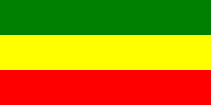
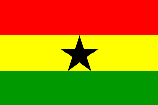
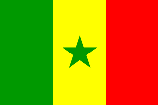

From left: The National Flag of Ethiopia c1897 1996; The National Flag of Ghana (fotw); The National Flag of Senegal (fotw);
National Flag of Benin (fotw)
- PAN-ARAB COLOURS (or COLORS)
- The white, black, red and green seen in the flags of a number of Arab countries and originally
said to be based upon lines by the Arab poet Safi al-Din al-H'ly
(see also core flag, difference,
'flag family',
pan-African colours above and
pan-Slavic colours below).

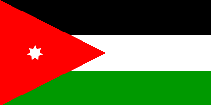


From left: Arab Revolt Flag 1917 (fotw); The National Flag of
Jordan (fotw); The National Flag of the Sudan (fotw); The National Flag of the
United Arab Emirates (fotw)
Please note that the lines mentioned in the
definition read: White are our deeds, black the fields of battle, our
pastures are green, but our swords are red with the blood of our enemy. and
that the first flag to used these colours was the Arab Liberation Flag of 1917
(as illustrated above).
- PAN-SLAVIC COLOURS (or COLORS)
- The blue, white and red originally adopted by the Slavic peoples during their struggles for independence from the Ottoman
and Habsburg empires, and derived from the national flag/civil ensign of the then Russian Empire (see also core flag,
difference,
'flag family', pan-African colours
and pan-Arab colours above)."
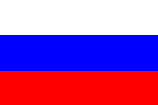
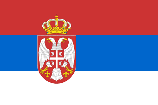
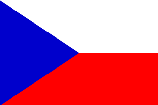
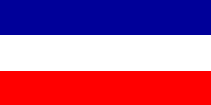
From left: The National Flag of Russia (fotw); The State Flag of Serbia (fotw);
The National Flag of the Czech Republic (fotw); National Flag of Yugoslavia
1992 2003 (fotw)
- PANEL
- The area of a flag that is surrounded by a border, the panel itself is generally
(but not exclusively) used to display charges or other designs (see also
border,
charge and pierced 1)).
- PANICLES
- A term used when loosely branching clusters of flowers and/or foliage form a wreath,
such as the panicles of rice on the army rank flags of Taiwan (see also
rank flag 1) and
wreath 1)).
![[panicles example]](../images/v/vxt-d508.gif)
flag of a Lt General, Taiwan (fotw)
- PANTONE MATCHING SYSTEM (or PMS)
- An internationally recognized proprietary system of identifying colours by
a code number, and increasingly used for the official regulation of flag colours.
- PAPAL CROSS
- The term that describes a cross with three horizontal arms crossing the vertical, and considered to represent
the Papacy a triple-armed or triple cross (see also
cross 2),
cross of Lorraine,
orthodox cross and
two and a half armed cross).
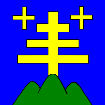

Flag of Binn, Switzerland (fotw); Flag of Vsetin, Czech Republic (fotw)
- PARADE FLAG
- 1) Generically, the term for any flag intended to be carried outdoors in a parade situation,
and made with appropriate materials and accessories.
- 2) Specifically, the term for that flag which is not a military colour as defined herein, but which is treated
and/or accessorized as such for example those of the Royal British Legion (see also
colour 2),
cord,
cravat,
fringe,
tassels,
sleeve 2),
staff 3) and
veterans flag).
Please note that there are basically three ways
involving a sleeve by which a parade flag or military colour may be affixed to
its staff - with decorative nails (often a precisely regulated number of nails),
by means of a grommet and clip, or by tab and screw (see also
grommet, 'nails'
sleeve 2) and
tab).
Note also however, that the practice of tying a
colour/parade flag to its staff, or attaching it by cloth loops or metal rings
is still occasionally seen (see also grommet,
sleeve 2), 'tab'
and ties).
- PARLAY (or PARLEY) FLAG
- See flag of truce.
- PARTI-COLOURED
- See counterchanged.
- PARTY
- The heraldic term that may be used when a shield or banner of arms is divided into two
horizontally, vertically or diagonally, or into four diagonally - see
per bend, per bend sinister,
per fess, per pale and per saltire).
Please note that this term is never used alone, but always with the term describing the
direction of any such division, for example party per fess.
- PARTY FLAG
- See political flag 1).
- PASCAL LAMB
- See agnus dei.
- PASSANT
- See Appendix V.
- PATRIARCHAL CROSS
- See cross of Lorraine.
- PAVILION
- The heraldic term for an ermine-lined velvet robe of state that is draped
from a crown or coronet and framing a royal or princely coat of arms. If behind
a non-royal coat of arms it becomes a mantle (see also
armorial bearings,
coat of arms,
crown, fur in
Appendix III and
mantle).
![[pavilion]](../images/v/vxt-d235.gif)
Grand-Ducal Arms of Liechtenstein (fotw)
- PAVISADE
- A term for the now obsolete practice of showing a decorative display of shields,
or by extension flags, along the sides of a ship.
![[pavisade]](../images/v/vxt-d237.gif)
English Pavisade c1530 (CS)
- PAVON
- A medieval term, now obsolete, for a large triangular flag/pennant whose lower edge was at right angles to the staff.
![[a possible pavon]](../images/v/vxt-d238.gif)
A Pavon (CS)
Please note that, whilst the term itself is entirely obsolete, the shape of flag (as illustrated above)
is not see dhvaja and (also
double-pavon).
- PAYING OFF PENNANT
- An extra long version of the standard masthead pennant; it is the tradition
in some navies that a ship on her final voyage, or at the end of an extended deployment
out of home waters, should fly a special pennant the length of which is commensurate
with the length of her last commission, or of the deployment being completed -
an action pennant, a homeward bound pennant or decommissioning pennant (see also
masthead pennant 1) & 2)).
See supplemental note:
![[pallia]](../images/v/vxt-d233.gif)















![[flags with pall]](../images/v/vxt-d231.gif)
![[illustration of a palm]](../images/v/vxt-d234.gif)
![[panicles example]](../images/v/vxt-d508.gif)
![[pavilion]](../images/v/vxt-d235.gif)
![[pavisade]](../images/v/vxt-d237.gif)
![[a possible pavon]](../images/v/vxt-d238.gif)